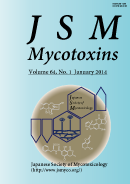Volume 64, Issue 1
Displaying 1-11 of 11 articles from this issue
- |<
- <
- 1
- >
- >|
Part I (Papers in English)
Research Papers
-
2014 Volume 64 Issue 1 Pages 1-14
Published: January 31, 2014
Released on J-STAGE: June 21, 2014
Download PDF (1285K) -
2014 Volume 64 Issue 1 Pages 15-21
Published: January 31, 2014
Released on J-STAGE: June 21, 2014
Download PDF (1352K)
Technical Note
-
2014 Volume 64 Issue 1 Pages 23-27
Published: January 31, 2014
Released on J-STAGE: June 21, 2014
Download PDF (1302K)
Part II (Papers in Japanese)
Proceedings of the 73th meeting
“Special lecture”
-
2014 Volume 64 Issue 1 Pages 37-43
Published: January 31, 2014
Released on J-STAGE: June 21, 2014
Download PDF (1551K)
“Topics”
-
2014 Volume 64 Issue 1 Pages 45-54
Published: January 31, 2014
Released on J-STAGE: June 21, 2014
Download PDF (1798K)
“Fusarium toxin today”
-
2014 Volume 64 Issue 1 Pages 55-62
Published: January 31, 2014
Released on J-STAGE: June 21, 2014
Download PDF (1614K) -
2014 Volume 64 Issue 1 Pages 63-68
Published: January 31, 2014
Released on J-STAGE: June 21, 2014
Download PDF (1293K) -
2014 Volume 64 Issue 1 Pages 69-74
Published: January 31, 2014
Released on J-STAGE: June 21, 2014
Download PDF (949K)
Minireviews
-
2014 Volume 64 Issue 1 Pages 75-86
Published: January 31, 2014
Released on J-STAGE: June 21, 2014
Download PDF (1517K) -
2014 Volume 64 Issue 1 Pages 87-94
Published: January 31, 2014
Released on J-STAGE: June 21, 2014
Download PDF (1430K) -
2014 Volume 64 Issue 1 Pages 95-103
Published: January 31, 2014
Released on J-STAGE: June 21, 2014
Download PDF (1142K)
- |<
- <
- 1
- >
- >|
